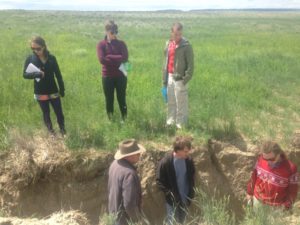I’ve been in Montana for about 21 days (15 days on WRFI course) and so far I’ve learned a lot from the  people I’ve met. From ranchers to coal mine operators to medical professionals to educators, one thing that connects all of these people is this: people here sure are resilient.
people I’ve met. From ranchers to coal mine operators to medical professionals to educators, one thing that connects all of these people is this: people here sure are resilient.
During the first week on course, we met with three such individuals. First, we stayed at a ranch near Billings belonging to Alexis Bonogofsky and Mike Scott. Alexis told us about her drawn-out fight with coal mining companies and railroad companies in the southeastern corner of the state. A proposed coal mine directly threatens the Northern Cheyenne, the Otter Creek Valley, and everyone living downstream along the Tongue River. The proposed connecting railroad to transport the coal will also create pollution and noise disturbances as rail traffic increases through towns to the west coast, where the coal would be exported.
Alexis has been doggedly fighting the prospect for so long that she has truly made it her life. In addition to this fight, Alexis is also still struggling to reclaim her land from an oil spill during high water of 2011. The oily water covered much of her grazing area and Exxon’s early attempts to fix the soil only made it worse. Now it will take years for the soil to regain its health and for Alexis’ herd of goats to graze it once again. Although she admits to sometimes feeling the all-too-human sense of discouragement, Alexis stressed this lesson to us: You must find your one passion and put everything into it – you will be more focused and work better this way.
Another person we met with has also been fighting continuous battles on various fronts for a long time. Steve Charter is a rancher who manages 8,000 acres of grazing land for his cattle – fairly small acreage by Montana standards. But what he’s doing with that land is no small feat. Through careful management of his cattle, Steve works to sequester carbon in the soil – a process that takes years to effect very little change. He continues to work on it and has decided to devote most of his focus towards his soil. He’s also involved in lawsuits with Signal Peak Energy, the company that mines coal under some of his pastures. The underground mining technique causes the surface land to subside, or hollow out, in some places. This is dangerous to his cattle and the method of remediation isn’t entirely environmentally friendly – the mining company fills the deep cracks with quick-drying cement and puts a layer of topsoil on top of it. Steve Charter hasn’t backed down and continues to fight these long battles when many other people have given up. The lesson I learned from him is to have patience because environmental battles can take a very long time.
We also met with Jean Wallace, a retired guidance counselor who lives in an impressive passive-solar house with her own wind turbine and photovoltaic array. She designed and built the house by hand with her late husband, back when architects and contractors didn’t know anything about passive solar. Even though it’s built into a hillside and mostly covered with an earthen roof, lots of light enters the huge south-facing windows and makes it a very enjoyable place to be. Jean’s clear message to us was to continue fighting for what we’re passionate about, even if we get resistance. She believes that one can’t make lasting change by creating fear, and that we have to encourage a shift in attitudes in order to see a change in behavior. If we keep up the hard work fighting for a cause rather than against something, we can be more effective in changing things for the better.
These are just three out of many speakers we have met with that have shown persistence, patience, determination, and resilience. Overall, the message from many of our speakers has been hopeful: college students and young people can change the world. It’s a lot to have on our plates, but if we are resilient and hard-working like the people we have met with on this trip, then we can make that change.